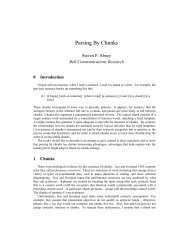The English Noun Phrase in its Sentential Aspect - Vinartus
The English Noun Phrase in its Sentential Aspect - Vinartus
The English Noun Phrase in its Sentential Aspect - Vinartus
You also want an ePaper? Increase the reach of your titles
YUMPU automatically turns print PDFs into web optimized ePapers that Google loves.
1. GENERAL SIMILARITIES 25<strong>in</strong> (19a) and the sentential subject of (19b), it was necessary to derivethem both from the same simplex sentence, viz., Nero destroyed Rome.<strong>The</strong> relevant part of the <strong>in</strong>terpretation of simplex sentences is represented<strong>in</strong> the current theory by -grids by assum<strong>in</strong>g destroy and destruction havethe same -grid, we can dispense with the transformational account of (19).Sentences and noun phrases are also similar with respect to processeslike control and b<strong>in</strong>d<strong>in</strong>g. <strong>The</strong> basic b<strong>in</strong>d<strong>in</strong>g facts are the same <strong>in</strong> sentenceand noun phrase:(20) John i portrayed himself iJohn i 's protrayal of himself i*himself i portrayed John i /him i*his own i portrayal of John i /him iJohn recommended for [himself i to portray himself i ]John recommended [his own i portrayal of himself i ]*John recommended for [himself i to portray him i ]*John recommended [his own i portrayal of him i ]Control facts are also similar <strong>in</strong> noun phrase and sentence.clauses can only be controlled by the subject, not the object:Adjunct(21) a. John criticized Bill j after his j talk.b. John's criticism of Bill j after his j talk.c. *John criticized Bill j after PRO j talk<strong>in</strong>g.d. *John's criticism of Bill j after PRO j talk<strong>in</strong>g.(Both (c) and (d) are ne where John controls PRO.)When Chomsky <strong>in</strong>troduced a non-transformational account of the thematicsimilarities between sentence and noun phrase (Chomsky 1970), healso considered the fact that a structural subject-object dist<strong>in</strong>ction wasnecessary <strong>in</strong> the noun phrase as well as sentence, and <strong>in</strong>troduced the nodeN|and X-theory|precisely for this reason. If we dene c-command as follows: c-commands if neither dom<strong>in</strong>ates the other, and the rst (branch<strong>in</strong>g)node dom<strong>in</strong>at<strong>in</strong>g dom<strong>in</strong>ates then with the <strong>in</strong>troduction of N-bar,the noun phrase and sentence are similar enough <strong>in</strong> structure to accountfor the facts of (20) and (21). <strong>The</strong> \subjects" of both noun phrase andsentence assymetrically c-command the objects, allow<strong>in</strong>g us to capture theassymetry <strong>in</strong> b<strong>in</strong>d<strong>in</strong>g and control facts.A po<strong>in</strong>t onwhichsentence and noun phrase rema<strong>in</strong> dissimilar, underChomsky's account|which has become the standard account |is Case-



